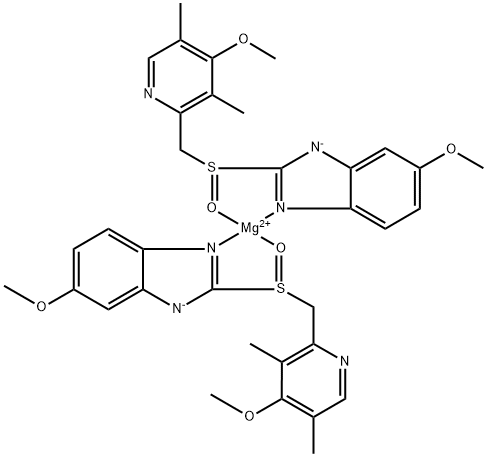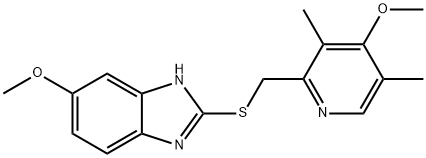Esomeprazole magnesium
- CAS No.
- 161973-10-0
- Chemical Name:
- Esomeprazole magnesium
- Synonyms
- Chebi:50309;S-Form magnesium salt;Esomeprazole magnesium;(-)-Omeprazole Magnesium;Esomeprazole magnesium API;ESOMEPRAZOLE MAGNESIUM/SODIUM;ESOMEPRAZOLE MAGNESIUM SAMPLE;NEXIUM(esomeprazolemagnesium);EsoMeprazole MagnesiuM(NexiuM);Esomeprazole magnesium USP/EP/BP
- CBNumber:
- CB81104336
- Molecular Formula:
- C34H36MgN6O6S2
- Molecular Weight:
- 713.12
- MDL Number:
- MOL File:
- 161973-10-0.mol
| Melting point | >169°C (dec.) |
|---|---|
| alpha | D20 -128.2° (c = 1 in methanol) |
| storage temp. | under inert gas (nitrogen or Argon) at 2-8°C |
| solubility | DMSO (Slightly), Methanol (Slightly) |
| form | Solid |
| color | Off-White to Beige |
| BCS Class | 3 |
| Stability | Hygroscopic |
| NCI Dictionary of Cancer Terms | esomeprazole magnesium |
| FDA UNII | 925R0D7W1O |
| NCI Drug Dictionary | esomeprazole magnesium |
SAFETY
Risk and Safety Statements
| Symbol(GHS) |  GHS07 |
|||||||||
|---|---|---|---|---|---|---|---|---|---|---|
| Signal word | Warning | |||||||||
| Hazard statements | H302-H315-H319-H335 | |||||||||
| Precautionary statements | P261-P280-P301+P312-P302+P352-P305+P351+P338 | |||||||||
| NFPA 704 |
|
Esomeprazole magnesium price More Price(34)
| Manufacturer | Product number | Product description | CAS number | Packaging | Price | Updated | Buy |
|---|---|---|---|---|---|---|---|
| Cayman Chemical | 17326 | Esomeprazole Magnesium ≥95% | 161973-10-0 | 10mg | $34 | 2024-03-01 | Buy |
| Cayman Chemical | 17326 | Esomeprazole Magnesium ≥95% | 161973-10-0 | 25mg | $67 | 2024-03-01 | Buy |
| Cayman Chemical | 17326 | Esomeprazole Magnesium ≥95% | 161973-10-0 | 50mg | $85 | 2024-03-01 | Buy |
| TRC | E668300 | Esomeprazole magnesium | 161973-10-0 | 100mg | $180 | 2021-12-16 | Buy |
| Usbiological | E3509 | Esomeprazole Magnesium | 161973-10-0 | 25mg | $389 | 2021-12-16 | Buy |
Esomeprazole magnesium Chemical Properties,Uses,Production
Overview
Esomeprazole is the latest in the class of agents called the protonpump inhibitors(PPIs). These drugs inhibit gastric hydrochloric acid secretion by binding to hydrogen– potassium adenosinetriphosphatase (H+, K+-ATPase) in gastric parietal cells. The PPIs’ ability to provide rapid symptomatic control and their demonstrated efficacy in healing erosive esophagitis have led them to be viewed as agents of choice for treating patients with gastric acid-related diseases, including gastroesophageal reflux disease(GERD), gastric ulcers, and duodenal ulcers. In addition, these agents have been shown to be effective in the treatment of Zollinger–Ellison syndrome and Barrett's esophagus[1, 2]. Esomeprazole is the fourth PPI to be approved for use in the United States, following omeprazole; the other available PPIs are lansoprazole, pantoprazole, and rabeprazole[3-7]. PPIs have similar chemical structures and a shared mechanism of action. Esomeprazole, the S-isomer of omeprazole, is the first PPI developed as a single optical isomer. Esomeprazole has an improved pharmacokinetic profile over omeprazole (a racemic mixture of Sand Roptical isomers), resulting in more potent acid suppression.
Esomeprazole, like the other PPIs, does this by accumulating in the secretory canaliculus of the parietal cell when the cell is secreting hydrochloric acid. After accumulating in this acidic environment, these agents are converted to a tetracyclic sulfenamide, which binds covalently to sulfhydryl groups of H+, K+-ATPase, rendering it inactive. The enzyme’s inactivation blocks the final step of hydrochloric acid secretion into the stomach, resulting in a higher gastric pH. The covalent binding of PPIs to H+, K+-ATPase is irreversible; restoration of gastric acid production depends on the rate of de novo proton-pump regeneration, not how long plasma drug levels are maintained[2, 8-10].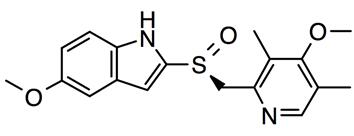
Figure 1 the chemical structure of esomeprazole;
Chemical properties
Esomeprazole is the S-isomer (enantiomer) of omeprazole, and the first PPI to be developed as an optical isomer. Similar to other PPIs, esomeprazole suppresses gastric acid secretion by inhibiting the parietal cell membrane enzyme, H+/K+-ATPase. Esomeprazole is rapidly degraded in acidic media but is stable under alkaline conditions just as all other PPIs are. Each capsule of esomeprazole magnesium contains enteric-coated granules to prevent esomeprazole degradation by gastric acidity. Esomeprazole, chemical name:(S)-5-methoxy-2-([(4-methoxy-3,5-dimethyl-2-pyridinyl) methyl]sulfinyl)-1H-benzimidazole, is a weak base. It is converted to its active form, a sulfenamide analog, in the acidic environment of the gastric parietal cell. It effectively blocks acid secretion by irreversibly binding to and inhibiting the enzyme H+/K+-ATPase that resides on the luminal surface of the parietal cell membrane, resulting in disulfide bond formation with cysteine 813 located within the α-subunit of the enzyme. This is the residue that is intimately involved in H+ transport. All PPIs are weak protonatable pyridines, with a pKa 4.0 for omeprazole, esomeprazole and lansoprazole, 3.9 for pantoprazole and 5.0 for rabeprazole. The rate of conversion varies among the compounds and is inversely proportional to their pKa: that is, rabeprazole> omeprazole/esomeprazole = lansoprazole> pantoprazole. As a result, they accumulate specifically and selectively in the secretory canaliculus, the highly acidic space, of the parietal cell[11]. Within that space, PPIs undergo an acid catalyzed conversion to become a reactive species, the thiophilic sulfenamide, which are permanent cations.
Indications
Esomeprazole, a proton-pump inhibitor (PPI), is the S-isomer of omeprazole. Esomeprazole has FDA-approved labeling for use in the treatment of symptomatic gastroesophageal reflux disease (GERD), including healing and maintenance of healing of erosive esophagitis and as part of a triple-drug regimen for Helicobacter pylori infection.
Pharmakinetics
Inhibition of acid secretion by esomeprazole is correlated with the area under the drug’s plasma concentration-versus-time curve (AUC)[12, 13]. Inverse correlation between AUC and pentagastrin-stimulated peak acid output was demonstrated in a randomized crossover trial in 12 healthy volunteers[13]. The subjects were given esomeprazole magnesium 5mg, 10mg, or 20 mg once daily or omeprazole 20 mg once daily for five days. (Except where specified otherwise, all dosages in this article are oral.) At the end of the treatment period, the inhibition of peak acid output was 28%, 62%, and 90% for the 5-, 10-, and 20-mg/day dosages of esomeprazole magnesium, respectively. Esomeprazole magnesium 20 mg/day yielded greater inhibition of peak acid output than omeprazole 20 mg/day(90% versus 79%) and had a 70% larger AUC. Other studies of the efficacy of esomeprazole compared with other PPIs are described later in the article. These trials demonstrate the pharmacodynamic difference of esomeprazole, which may account for differences in clinical efficacy seen in some studies.
Following administration of a 40 mg dose of esomeprazole magnesium, the AUC is 33–53% lower after eating than during fasting conditions[3]. Plasma concentrations peak approximately 1.5 hours after a dose. As the dose increases, both the peak plasma concentration and the AUC also increase. An increase in the esomeprazole magnesium dosage from 20 to 40 mg/day results in a threefold increase in the AUC after five days of treatment.
Hassan-Alin et al[14] evaluated the pharmacokinetics of single and repeated oral and intravenous doses of esomeprazole in healthy subjects. The systemic bioavailability of esomeprazole magnesium 40mg once daily was 90% after five days of treatment, compared with 65% after a single dose. The AUC increased from day 1 to day 5 by159% (from 4.32 to 11.21 μmol • hr/L). The authors concluded that the AUC probably increased as a result of both decreased systemic clearance and decreased first-pass elimination.
The plasma half-life of esomeprazole is 1–1.5 hours, and the drug is 97% plasma protein bound[3]. Esomeprazole undergoes extensive hepatic metabolism via the CYP isoenzyme system. About 80% of a dose of esomeprazole is excreted in the urine as inactive metabolites; the remainder is eliminated as inactive metabolites in the feces. Less than 1% of a dose is excreted in the urine as the active drug.
Mode of action
Esomeprazole is potent inhibitors of the final common pathway for gastric acid secretion by gastric parietal cells. A weak base, esomeprazole concentrates in the acidic compartment of secretory canaliculus of the parietal cells where it undergoes an acid-catalyzed transformation to a tetracyclic achiral cationic sulfonamide[15]. Inhibition of the H+/K+-ATPase enzyme occurs when the sulfonamide reacts with specific cysteine, blocking the final step in acid production and leading to adose-dependent reduction of gastric acid secretion. The binding of esomeprazole to the proton pump is covalent and irreversible[16, 17].
Drug interaction
Esomeprazole inhibits gastric acid secretion, which interferes with the absorption of medications requiring an acid medium for absorption (e.g., itraconazole). Like omeprazole, esomeprazole is metabolized via CYP2C19 and CYP3A4. Esomeprazole may inhibit the CYP2C19 pathway, which could interfere with other medications metabolized via this pathway. A 45% decrease in the clearance of diazepam in patients also taking esomeprazole has been reported[3]. However, the clinical relevance of this and other potential interactions is unknown. There do not appear to be any clinically significant interactions with phenytoin, warfarin, quinidine, or clarithromycin[3]. Other medications metabolized by CYP2C19 include phenytoin, cyclophosphamide, and some tricyclic antidepressants. These could be involved in interactions with esomeprazole. The possibility of interactions should be kept in mind when esomeprazole is used concurrently with products metabolized by CYP2C19 that have a low therapeutic index.
Adverse reactions
Adverse effects and tolerability have been recorded in several efficacy trials[18-23, 25,26]. The most commonly reported adverse effects were headache, respiratory infection, abdominal pain, nausea, and diarrhea[18-20]. Esomeprazole was generally well tolerated and was not significantly different from omeprazole in overall safety and tolerability(as would be expected, given that esomeprazole is an isomer of omeprazole).
Esomeprazole is a pregnancy category B agent. Reproductive studies in animals have found no evidence of impaired fertility or harm to the fetus in subjects receiving the equivalent (based on body surface area) of up to 57 times the human dosage[3]. By comparison, omeprazole has caused dose-related increases in embryo death, embryo and fetal toxicity, fetal resorption, pregnancy disruptions, and postnatal development problems when dosages equivalent to 5.5– 56 times the human dosage were given to animals[3]. There have been no well-controlled studies of esomeprazole or omeprazole in pregnant women. However, congenital abnormalities in infants born to women who received omeprazole during pregnancy have been sporadically reported[3]. Considering these reports, and since animal reproductive studies are not always predictive of human response, esomeprazole should be used during pregnancy only when the need is compelling.
Precaution
Before taking this medicine, the patients should keep in mind of the following tips:
Heartburn can mimic early symptoms of a heart attack. Get emergency medical help if you have chest pain that spreads to your jaw or shoulder and you feel anxious or light-headed. Don’t take this medicine if you are allergic to esomeprazole or to similar medicines such as lansoprazole, omeprazole, pantoprazole, rabeprazole, Dexilant, Nexium, Prevacid, Protonix, and others.
You should consult your doctor if you have the history of the following cases including severe liver disease, lupus, osteoporosis or low bone mineral density(osteopenia); or low levels of magnesium in your blood.
You may be more likely to have a broken bone in your hip, wrist, or spine while taking a proton pump inhibitor long-term or more than once per day. Talk with your doctor about ways to keep your bones healthy. Ask a doctor before using this medicine if you are pregnant or breast-feeding.
Reference
- Grover JK, Vats V. Proton pump inhibitors. Trop Gastroenterol. 1999; 20:16-28.
- Horn J. The proton-pump inhibitors: similarities and differences. Clin Ther. 2000; 22:266-80.
- Nexium (esomeprazole magnesium) delayed-release capsules package insert. Wilmington, DE: AstraZeneca; 2001.
- Prevacid (lansoprazole) delayed-release capsules package insert. Lake Forest, IL: TAP Pharmaceuticals; 2000.
- Prilosec (omeprazole) delayed-release capsules package insert. Wilmington, DE: AstraZeneca; 2000.
- Protonix (pantoprazole sodium) delayedrelease tablets package insert. Philadelphia: Wyeth Laboratories; 2000.
- Aciphex (rabeprazole sodium) delayedrelease tablets package insert. Teaneck, NJ: Eisai; 1999.
- Sachs G. Proton pump inhibitors and acid-related diseases. Pharmacotherapy. 1997; 17:22-37.
- Thitiphuree S, Talley NJ. Esomeprazole, a new proton pump inhibitor: pharmacological characteristics and clinical efficacy. Int J Clin Pract. 2000; 54:537-41.
- Spencer CM, Faulds D. Esomeprazole. Drugs. 2000; 60:321-9.
- Shin JM, Sachs G. Restoration of acid secretion following treatment with proton pump inhibitors. Gastroenterology 123, 1588–1597 (2002).
- Junghard O, Hassan-Alin M, Hasselgren G. The effect of AUC and Cmax of esome prazole on acid secretion and intragastric pH. Gastroenterology. 2000; 118(suppl 2, pt. 1):A17. Abstract.
- Andersson T, Ro?hss K, Hassan-Alin M et al. Pharmacokinetics (PK) and doseresponse relationship of esomeprazole (E). Gastroenterology. 2000; 118(suppl 2, pt. 2):A1210. Abstract.
- Langtry HD, Wilde MI. Omeprazole: a review of its use in Helicobacter pylori infection, gastro-oesophageal reflux disease and peptic ulcers induced by nonsteroidal anti-inflammatory drugs. Drugs. 1998; 56:447-86.
- Nexium[prescribing information]. Wilmington (DE): AstraZeneca LP, 2003.
- Zimmermann AE: Esomeprazole: a novel proton pump inhibitor for the treatment of acid-related disorders. Formulary (2000) 35: 882-893.
- Huang J-Q, Hunt R: Pharmacological and pharmacodynamic essentials of H2-receptor antagonists and proton pump inhibitors for the practicing physician. Baillieres Best Pract. Res. Clin. Gastroenterol (2001) 15: 355-370.
- Kahrilas PJ, Falk GW, Johnson DA et al. Esomeprazole improves healing and symptom resolution as compared with omeprazole in reflux oesophagitis patients: a randomized controlled trial. Aliment Pharmacol Ther. 2000; 14:1249-58.
- Richter JE, Kahrilas PJ, Johanson J et al. Efficacy and safety of esomeprazole compared with omeprazole in GERD patients with erosive esophagitis: a randomized controlled trial. Am J Gastroenterol. 2001; 96:656-65.
- Johnson DA, Benjamin SB, Nimish B et al. Esomeprazole once daily for 6 months is effective therapy for maintaining healed erosive esophagitis and for controlling gastroesophageal reflux disease symptoms: a randomized, double-blind, placebo-controlled study of efficacy and safety. Am J Gastroenterol. 2001; 96:27-34.
- Maton P, Vakil NB, Hwang C et al. Safety and efficacy of long-term treatment with esomeprazole in patients with healed erosive esophagitis (EE). Gastroenterology. 2000; 118(suppl 2, pt. 1):A19. Abstract.
- Vakil NB, Shaker R, Hwang C et al. Esomeprazole is effective as maintenance therapy in GERD patients with healed erosive esophagitis (EE). Gastroenterology. 2000; 118(suppl 2, pt. 1):A22. Abstract.
- Laine L, Fennerty MB, Osato M et al. Esomeprazole-based Helicobacter pylori eradication therapy and the effect of antibiotic resistance: results of three US multicenter, double-blind trials. Am J Gastroenterol. 2000; 95:3393-8.
- Lind T, Rydberg L, Kyleba?ck A et al. Esomeprazole provides improved acid control vs. omeprazole in patients with symptoms of gastro-oesophageal reflux disease. Aliment Pharmacol Ther. 2000; 14:861-7.
- Talley NJ, Lauritsen K, Tunturi-Hihnala H et al. Esomeprazole 20 mg maintains symptom control in endoscopy-negative gastro-oesophageal reflux disease: a controlled trial of ‘on-demand’ therapy for 6 months. Aliment Pharmacol Ther. 2001; 15:347-54.
- https://www.drugs.com/mtm/esomeprazole.html
Uses
S-Form of Omeprazole. Gastric proton-pump inhibitor.
Uses
Antiulcerative
Definition
ChEBI: A magnesium salt resulting from the formal reaction of magnesium hydroxide with 2 mol eq. of esomeprazole. An inhibitor of gastric acid secretion, it is used for the treatment of gastro-oesophageal reflux disease, dyspepsia, peptic ulcer disease, and Zolli ger-Ellison syndrome.
brand name
Nexium (AstraZeneca).
General Description
Esomeprazole magnesium,S-bis(5-rnethoxy-2-[(S)-[(4-methoxy-3,5-dimethyl-2-pyridinyl)methyl]sulfinyl]-1H-benzimidazole-l-yl) magnesiumtrihydrate (Nexium), is the S-enantiomer ofomeprazole. The benzimidazole PPIs contain a chiral sulfuratom that form an enantiomeric pair that is stable andinsoluble under standard conditions. The S-isomer ofomeprazole has slightly greater PPI activity, and its intrinsicclearance is approximately three times lower thanthat of R-omeprazole (15 vs. 43μL/min). The lowerclearance of S-omeprazole is related to slower metabolicclearance by the CYP2C19 isozyme. Although Romeprazoleis primarily transformed to the 5-hydroxymetabolite, the S-isomer is metabolized by O-demethylationand sulfoxidation, which contribute little to intrinsicclearance.
Esomeprazole magnesium Preparation Products And Raw materials
| Supplier | Tel | Country | ProdList | Advantage | |
|---|---|---|---|---|---|
| Xinyi Dajiang Chemical Co.,Ltd. | +8617314178111 | 243096958@qq.com | China | 5 | 58 |
| Henan Bao Enluo International TradeCo.,LTD | +86-17331933971 +86-17331933971 | deasea125996@gmail.com | China | 2503 | 58 |
| Sigma Audley | +86-18336680971 +86-18126314766 | nova@sh-teruiop.com | China | 525 | 58 |
| Henan Tianfu Chemical Co.,Ltd. | +86-0371-55170693 +86-19937530512 | info@tianfuchem.com | China | 21695 | 55 |
| ATK CHEMICAL COMPANY LIMITED | +undefined-21-51877795 | ivan@atkchemical.com | China | 32480 | 60 |
| Shanghai Zheyan Biotech Co., Ltd. | 18017610038 | zheyansh@163.com | CHINA | 3620 | 58 |
| career henan chemical co | +86-0371-86658258 | sales@coreychem.com | China | 29914 | 58 |
| Shandong chuangyingchemical Co., Ltd. | 18853181302 | sale@chuangyingchem.com | CHINA | 5909 | 58 |
| Chongqing Chemdad Co., Ltd | +86-023-61398051 +8613650506873 | sales@chemdad.com | China | 39916 | 58 |
| CONIER CHEM AND PHARMA LIMITED | +8618523575427 | sales@conier.com | China | 47465 | 58 |
Related articles
- Esomeprazole Magnesium: Overview, Side Effects and Dosage
- Esomeprazole magnesium treats acid-related disorders with specific dosages, requiring caution due to potential severe side eff....
- Feb 19,2024
- Esomeprazole magnesium: mechanism of action, pharmacokinetics and safety
- Esomeprazole magnesium reduces stomach acid production by selectively inhibiting the proton pump, providing long-lasting relie....
- Sep 27,2023
- Esomeprazole Magnesium Uses
- Esomeprazole is the S-isomer (enantiomer) of omeprazole, and the first PPI to be developed as an optical isomer. Similar to ot....
- Sep 11,2019
View Lastest Price from Esomeprazole magnesium manufacturers
| Image | Update time | Product | Price | Min. Order | Purity | Supply Ability | Manufacturer | |
|---|---|---|---|---|---|---|---|---|
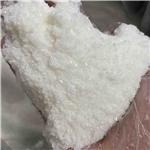 |
2024-03-16 | Esomeprazole magnesium
161973-10-0
|
US $35.00-25.00 / kg | 1kg | 99.8% | 200tons/year | Sigma Audley | |
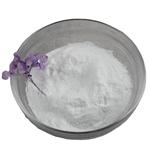 |
2023-08-04 | Esomeprazole magnesium
161973-10-0
|
US $120.00 / kg | 1kg | 99% | 1000tons | Henan Bao Enluo International TradeCo.,LTD | |
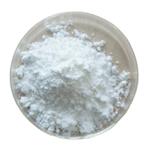 |
2023-07-31 | Esomeprazole magnesium
161973-10-0
|
US $10.00-20.00 / kg | 1kg | 99%+ | 6000kg/Month | Hebei Linwo New Material Technology Co., LTD |
-

- Esomeprazole magnesium
161973-10-0
- US $35.00-25.00 / kg
- 99.8%
- Sigma Audley
-

- Esomeprazole magnesium
161973-10-0
- US $120.00 / kg
- 99%
- Henan Bao Enluo International TradeCo.,LTD
-

- Esomeprazole magnesium
161973-10-0
- US $10.00-20.00 / kg
- 99%+
- Hebei Linwo New Material Technology Co., LTD
161973-10-0(Esomeprazole magnesium)Related Search:
1of4





